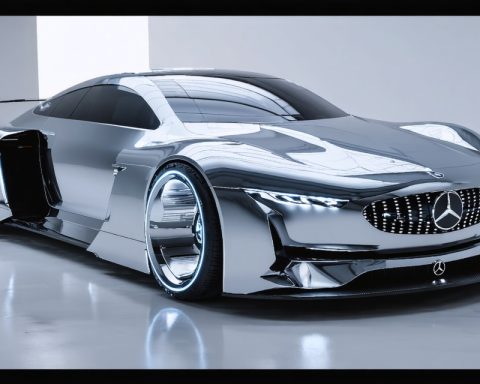- Polestar, a Swedish EV brand, is expanding its presence in the U.S. with a strategic focus on Tesla’s market share, offering significant discounts to attract Tesla customers.
- The Polestar 3’s competitive price of $73,000 positions it against the pricier Tesla Model S, capitalizing on Tesla’s recent challenges and client dissatisfaction.
- The brand’s 76% surge in deliveries reflects successful targeted campaigns, underscored by dynamic market conditions and Elon Musk’s controversial political involvement.
- Manufacturing in South Carolina reduces Polestar’s reliance on China, aligning with broader industry shifts amid U.S.-China trade tensions.
- Other automakers like Ford and Stellantis are adopting similar strategies, investing substantially in the electric market.
- Polestar’s vision focuses on achieving independence and long-term success, leveraging resilience and agility in the competitive EV market.
A sleek new contender is electrifying the auto industry, leaving a trail of curiosity and interest in its wake. Polestar, the Swedish electric vehicle (EV) brand, is turbocharging its presence in the U.S. market with an audacious strategy that combines allure and leverage. As Tesla grapples with scrutiny and fluctuating confidence, Polestar seizes the moment with a strategic sprint—a financial overture aimed directly at Tesla’s increasingly restless clientele.
The world watched as Polestar deftly maneuvered through the first quarter with a 76% surge in vehicle deliveries, driven primarily by a savvy, targeted conquest campaign. The core of this campaign unfolds like a well-scripted drama: Tesla owners lured by tantalizing discounts of up to $20,000 on the chic Polestar 3. This audacious offer repositions the price of the high-end Polestar 3 to a surprisingly competitive $73,000, overshadowing the heftier tag of a souped-up Tesla Model S, just under $80,000.
Amid rising client dissatisfaction with Tesla—compounded by erratic market swings and CEO Elon Musk’s controversial ventures into U.S. politics—the muscled overture from Polestar was met with propulsion rather than resistance. The Swedish automaker intended not just to disrupt but to redefine—a vision underscored by soaring sales figures and enthusiastic new owner testimonials.
Strategically expanding its roots in American soil, Polestar’s U.S. ambitions transcend the battlefield of discounts. The Polestar 3 rolls off the lines at Volvo Cars’ manufacturing haven in South Carolina, marking a decisive step toward reduced dependency on Chinese manufacturing—a pragmatic move against the backdrop of intensifying U.S.-China trade tensions. Other automotive giants, including Ford and Stellantis, find themselves echoing this shift, offering their own enticements to stay competitive amidst looming tariff hikes.
The competitive landscape is not for the faint-hearted. Giants like General Motors and Hyundai are thrusting in colossal investments, to the tune of $21 billion, into the electric future. Meanwhile, Lucid motors, another electric beacon, courts Tesla’s clientele with its own luxury offerings. Yet, Polestar, with its calculated audacity, stakes its claim, crafting an indelible mark in this fiercely competitive race.
At the heart of this electrifying ascension lies Polestar’s desire to leap from reliance to independence. The brand’s meticulous pivot is driven by a renewed leadership vision, emphasizing self-sufficiency alongside aggressive sales tactics. As the tale unfolds, Polestar’s Tesla Conquest Offer may signal more than clever marketing—it might just illuminate a strategy primed for long-term success in the dynamic currents of the EV market.
Powered by its strategic foresight and innovative enticements, Polestar paints a vivid picture of possibility and resilience. With eyes firmly set on growth, the brand is a compelling undercurrent in a marketplace ripe with potential and transformation, proving that in the realm of electric vehicles, agility and vision will eclipse mere size.
Polestar vs. Tesla: The Silent Revolution in the Electric Vehicle Market
The Rising Star: Polestar’s Game-Changing Strategy
In a marketplace dominated by Tesla’s looming presence, Polestar emerges as a dynamic contender reshaping the electric vehicle (EV) landscape. While Tesla faces fluctuating confidence levels and CEO Elon Musk’s controversial forays into U.S. politics, Polestar is strategically leveraging this moment with innovative tactics.
Key Insights and Features of Polestar’s Assault on the EV Market
1. Financial Strategy with a Twist: Polestar’s audacious discount strategy aims to directly attract disenchanted Tesla owners. By offering up to $20,000 in discounts on the Polestar 3, the high-cost EV game is transformed into a more accessible competition.
2. Production and Manufacturing: Polestar 3’s production at Volvo Cars’ plant in South Carolina signifies a pivotal move away from reliance on Chinese manufacturing. This not only aligns with U.S. economic interests but also insulates Polestar from potential U.S.-China trade-related disruptions. This trend is mirrored by other automakers such as Ford and Stellantis.
3. Broader Industry Trends: The overall EV industry investment landscape is evolving, with companies like General Motors and Hyundai investing significantly in EV technologies—about $21 billion combined. Polestar’s strategic efforts go beyond discounts, creating a robust market stance amidst growing competition.
4. Leadership and Vision: Polestar’s leadership is sharply focused on gaining independence in the market, not just through sales but through self-sufficiency and innovation. This dual approach strengthens their vision of long-term success and resilience in the EV sector.
How Polestar is Influencing EV Consumer Behavior
– Price Competitiveness: The strategic pricing of the Polestar 3 at a competitive $73,000 creates a compelling value proposition against the higher-priced Tesla Model S. This could redefine consumer perceptions of cost and value in the premium EV segment.
– Targeted Marketing: By directly enticing existing Tesla owners, Polestar is executing a precise market capture strategy. This approach not only expands its customer base but also sows seeds of doubt among Tesla’s followers about remaining loyal to their current brand.
Real-World Use Cases and Applications
– Sustainability and Innovation: Polestar’s foray into manufacturing within the U.S. aids in reducing the carbon footprint associated with shipping vehicles from overseas. This approach benefits eco-conscious consumers looking to minimize environmental impact.
– Consumer Versatility: With Polestar’s growing range of models, consumers now have more choices in design, features, and price points, allowing for more personalized vehicle selection.
Pros and Cons of Polestar’s Market Approach
Pros:
– Aggressive pricing increases market accessibility.
– Reducing dependency on China mitigates geopolitical risk.
– Innovative marketing strategies effectively target competitor’s customers.
Cons:
– Heavy reliance on discounts could impact profit margins.
– Competition remains stiff with established players like Tesla and new entrants like Lucid Motors.
Predictions and Future Outlook
Polestar’s bold strategy is poised to foster sustained growth. With evolving consumer expectations for both sustainability and innovation, Polestar is aptly positioned to meet these demands. Collaboration with other Swedish and European partners may further bolster its market position.
Actionable Recommendations
– For Consumers: If in the market for a premium EV, consider Polestar’s offerings for innovative features coupled with competitive pricing.
– For Investors: Monitor Polestar’s expansion strategies and production pivots as potential indicators of promising returns.
– For Competitors: Consider adapting aggressive tactics like targeted discounts and local production to maintain competitiveness.
For more information on the changing dynamics within the automotive sector, explore the insights from Polestar and stay updated with the latest in electric mobility.













